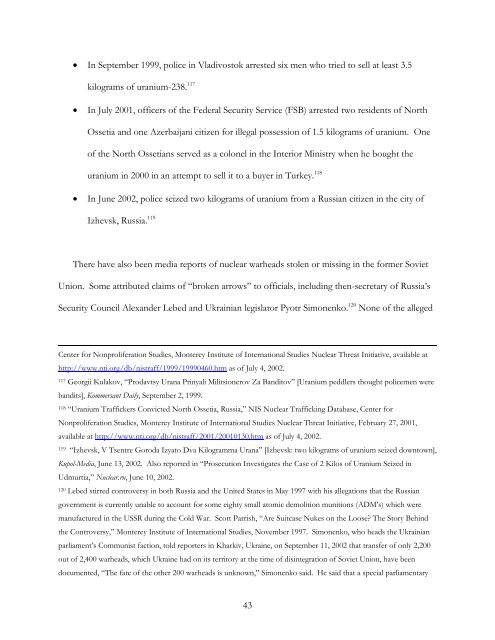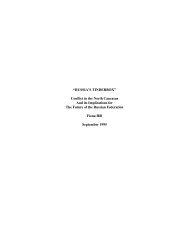Russia - Belfer Center for Science and International Affairs - Harvard ...
Russia - Belfer Center for Science and International Affairs - Harvard ...
Russia - Belfer Center for Science and International Affairs - Harvard ...
You also want an ePaper? Increase the reach of your titles
YUMPU automatically turns print PDFs into web optimized ePapers that Google loves.
• In September 1999, police in Vladivostok arrested six men who tried to sell at least 3.5<br />
kilograms of uranium-238. 117<br />
• In July 2001, officers of the Federal Security Service (FSB) arrested two residents of North<br />
Ossetia <strong>and</strong> one Azerbaijani citizen <strong>for</strong> illegal possession of 1.5 kilograms of uranium. One<br />
of the North Ossetians served as a colonel in the Interior Ministry when he bought the<br />
uranium in 2000 in an attempt to sell it to a buyer in Turkey. 118<br />
• In June 2002, police seized two kilograms of uranium from a <strong>Russia</strong>n citizen in the city of<br />
Izhevsk, <strong>Russia</strong>. 119<br />
There have also been media reports of nuclear warheads stolen or missing in the <strong>for</strong>mer Soviet<br />
Union. Some attributed claims of “broken arrows” to officials, including then-secretary of <strong>Russia</strong>’s<br />
Security Council Alex<strong>and</strong>er Lebed <strong>and</strong> Ukrainian legislator Pyotr Simonenko. 120 None of the alleged<br />
<strong>Center</strong> <strong>for</strong> Nonproliferation Studies, Monterey Institute of <strong>International</strong> Studies Nuclear Threat Initiative, available at<br />
http://www.nti.org/db/nistraff/1999/19990460.htm as of July 4, 2002.<br />
117 Georgii Kulakov, “Prodavtsy Urana Prinyali Militsionerov Za B<strong>and</strong>itov” [Uranium peddlers thought policemen were<br />
b<strong>and</strong>its], Kommersant Daily, September 2, 1999.<br />
118 “Uranium Traffickers Convicted North Ossetia, <strong>Russia</strong>,” NIS Nuclear Trafficking Database, <strong>Center</strong> <strong>for</strong><br />
Nonproliferation Studies, Monterey Institute of <strong>International</strong> Studies Nuclear Threat Initiative, February 27, 2001,<br />
available at http://www.nti.org/db/nistraff/2001/20010130.htm as of July 4, 2002.<br />
119 “Izhevsk, V Tsentre Goroda Izyato Dva Kilogramma Urana” [Izhevsk: two kilograms of uranium seized downtown],<br />
Kupol-Media, June 13, 2002. Also reported in “Prosecution Investigates the Case of 2 Kilos of Uranium Seized in<br />
Udmurtia,” Nuclear.ru, June 10, 2002.<br />
120 Lebed stirred controversy in both <strong>Russia</strong> <strong>and</strong> the United States in May 1997 with his allegations that the <strong>Russia</strong>n<br />
government is currently unable to account <strong>for</strong> some eighty small atomic demolition munitions (ADM’s) which were<br />
manufactured in the USSR during the Cold War. Scott Parrish, “Are Suitcase Nukes on the Loose? The Story Behind<br />
the Controversy,” Monterey Institute of <strong>International</strong> Studies, November 1997. Simonenko, who heads the Ukrainian<br />
parliament’s Communist faction, told reporters in Kharkiv, Ukraine, on September 11, 2002 that transfer of only 2,200<br />
out of 2,400 warheads, which Ukraine had on its territory at the time of disintegration of Soviet Union, have been<br />
documented, “The fate of the other 200 warheads is unknown,” Simonenko said. He said that a special parliamentary<br />
43
















